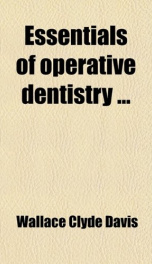essentials of operative dentistry

Purchase of this book includes free trial access to www.million-books.com where you can read more than a million books for free. This is an OCR edition with typos. Excerpt from book: CHAPTER III. Instrument Nomenclature. A dental instrument is an appliance, or tool by means ol which a dentist performs dental operations. It is quite essential that we learn the names and uses of the instruments most in use if we are to understand the teaching of operative procedures. Instruments are named according to the purpose for which they are intended, where and how used, by describing their working points and the shape of their shank. An order name describes that for which an instrument is used, as for example, excavator, clamps, mallet, pluggers, burnishers, etc. A sub-order name describes where or how an instrument of a given order is used and is made by inserting a prefix before the order name. Examples, hand pluggers push or pull sealers, etc. A class name describes the working point of an instrument. Examples, serrated plugger, ball burnisher, chisel, hatchet, etc. A sub-class name describes the shape of the shank, and is made by prefixing this description to the class or order name or to both combined. Examples, bayonet plugger, bin-angle chisel, mon-anglc hatchet excavator, etc. Rights and lefts are made as further divisions of many of the sub-classes of instruments and this division is especially advantageous in the spoons, bin-angle, contra-angle hatchets and marginal trimmers as it enables the user to do the work by a movement of the instrument from right to left or left to right, respectively. An excavator is that order of hand instrument used in the removal of tooth substance preparatory to the making of a filling. A chisel is that class of excavator which has the cutting edge placed at right angles to the shaft, is sharpened by grinding on one side only and is used by a pushing force applied in the direction of the long axis of t...
Info about the book
Author:
Series:
Unknown
ISBN:
0198564899
Rating:
3/5 (4)Your rating:
0/5
Languge:
English
Users who have this book
Users who want this book
What readers are saying
What do you think? Write your own comment on this book!
write a commentif you like essentials of operative dentistry try:
Other books by this author
Do you want to read a book that interests you? It’s EASY!
Create an account and send a request for reading to other users on the Webpage of the book!

